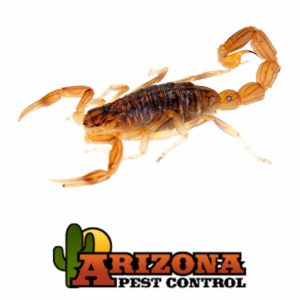Tucson is home to various scorpion species, but some are more common than others. Here are some of the scorpion species you might come across in Tucson:
Hadrurus Arizonensis (Giant Desert Hairy Scorpion)
The Giant Desert Hairy Scorpion is one of the largest scorpion species found in Tucson, growing up to six inches in length. They have a brownish-yellow color and hairy bodies. These scorpions are mostly found in rocky areas and feed on insects, spiders, and other arthropods.
Centruroides Sculpturatus (Arizona Bark Scorpion)
The Arizona Bark Scorpion is a small, light brown scorpion species found in Tucson. They are known for their venomous stings, which can be dangerous to humans. Arizona Bark Scorpions are nocturnal and hide during the day in crevices and other sheltered areas.
Vaejovis Confusus (Striped Tail Scorpion)
The Striped Tail Scorpion is a small scorpion species found in Tucson with a distinct black and yellow striped tail. They are usually found in rocky areas and feed on insects and other arthropods.
Scorpion Characteristics
Scorpions have unique characteristics that make them fascinating creatures. Here are some of the most notable characteristics of scorpions:
Venomous Stinger
Scorpions have a venomous stinger located at the end of their tail. While the venom of most scorpion species is not fatal to humans, it can cause pain, swelling, and other symptoms.
Nocturnal
Scorpions are primarily nocturnal creatures, which means they are most active at night. During the day, they hide in crevices and other sheltered areas to avoid the hot desert sun.
Unique Appearance
Scorpions have a unique appearance that sets them apart from other arthropods. Their pincers and long, segmented tails are distinctive features that make them easily recognizable.
Staying Safe from Scorpion Stings
While scorpion stings are generally not fatal to humans, they can be painful and cause discomfort. Here are some tips for staying safe from scorpion stings in Tucson:
Wear Protective Clothing
When hiking or exploring in areas where scorpions are present, it’s essential to wear protective clothing, such as long pants and closed-toe shoes. This can help prevent scorpions from crawling on your skin and stinging you.
Use a Blacklight
Scorpions fluoresce under blacklight, which means they will glow in the dark. Using a blacklight can help you spot scorpions in the dark and avoid getting stung.
Shake Out Clothing and Shoes
Before putting on clothing or shoes that have been left outside, it’s a good idea to shake them out to ensure that there are no scorpions hiding inside. Scorpions can easily crawl into shoes or clothing left on the ground, so shaking them out can help prevent accidental stings.
Seal Your Home
Scorpions can easily enter homes through small cracks and openings. Sealing your home and checking for any openings can help prevent scorpions from entering.
Be Mindful of Your Surroundings
When in areas where scorpions are present, it’s important to be mindful of your surroundings. Avoid putting your hands or feet in areas where you cannot see, such as under rocks or in crevices.
Scorpions are fascinating creatures that are found in abundance in Tucson, Arizona. Knowing the scorpion species in Tucson, their characteristics, and how to stay safe from their stings is essential for anyone living or visiting the area. By following the tips above, you can enjoy exploring Tucson’s beautiful wildlife without fear of getting stung.











